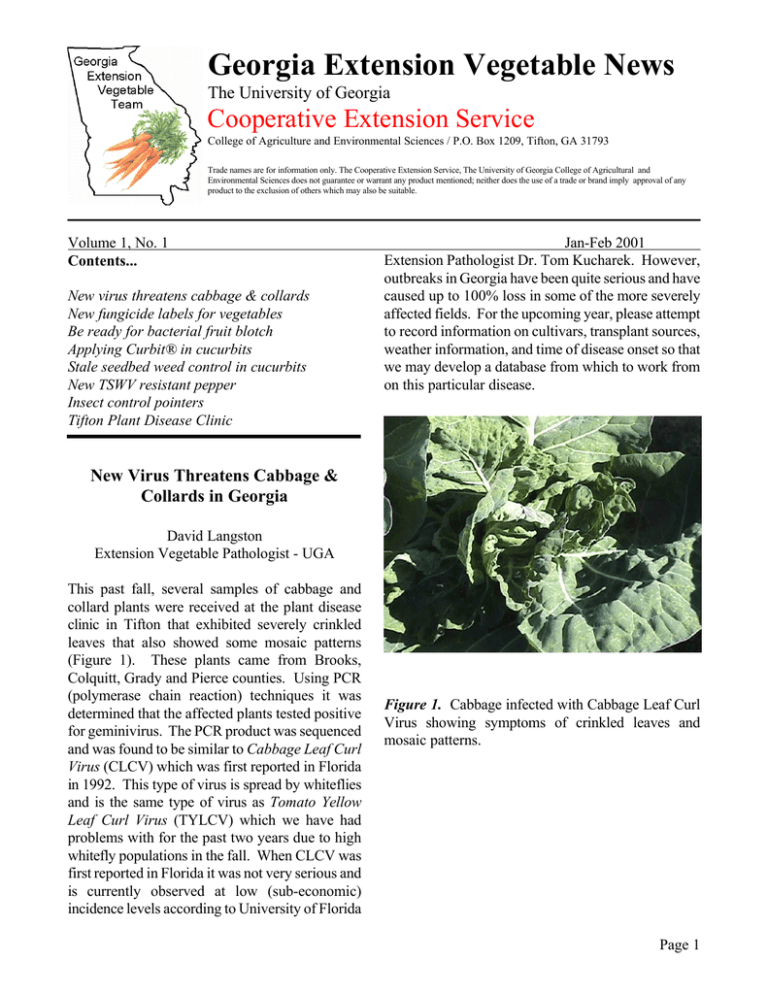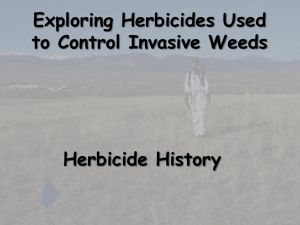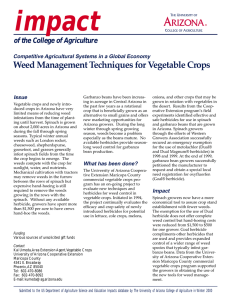Georgia Extension Vegetable News Cooperative Extension Service The University of Georgia
advertisement

Georgia Extension Vegetable News The University of Georgia Cooperative Extension Service College of Agriculture and Environmental Sciences / P.O. Box 1209, Tifton, GA 31793 Trade names are for information only. The Cooperative Extension Service, The University of Georgia College of Agricultural and Environmental Sciences does not guarantee or warrant any product mentioned; neither does the use of a trade or brand imply approval of any product to the exclusion of others which may also be suitable. Volume 1, No. 1 Contents... New virus threatens cabbage & collards New fungicide labels for vegetables Be ready for bacterial fruit blotch Applying Curbit® in cucurbits Stale seedbed weed control in cucurbits New TSWV resistant pepper Insect control pointers Tifton Plant Disease Clinic Jan-Feb 2001 Extension Pathologist Dr. Tom Kucharek. However, outbreaks in Georgia have been quite serious and have caused up to 100% loss in some of the more severely affected fields. For the upcoming year, please attempt to record information on cultivars, transplant sources, weather information, and time of disease onset so that we may develop a database from which to work from on this particular disease. New Virus Threatens Cabbage & Collards in Georgia David Langston Extension Vegetable Pathologist - UGA This past fall, several samples of cabbage and collard plants were received at the plant disease clinic in Tifton that exhibited severely crinkled leaves that also showed some mosaic patterns (Figure 1). These plants came from Brooks, Colquitt, Grady and Pierce counties. Using PCR (polymerase chain reaction) techniques it was determined that the affected plants tested positive for geminivirus. The PCR product was sequenced and was found to be similar to Cabbage Leaf Curl Virus (CLCV) which was first reported in Florida in 1992. This type of virus is spread by whiteflies and is the same type of virus as Tomato Yellow Leaf Curl Virus (TYLCV) which we have had problems with for the past two years due to high whitefly populations in the fall. When CLCV was first reported in Florida it was not very serious and is currently observed at low (sub-economic) incidence levels according to University of Florida Figure 1. Cabbage infected with Cabbage Leaf Curl Virus showing symptoms of crinkled leaves and mosaic patterns. Page 1 New Fungicide Labels for Vegetables David Langston Extension Vegetable Pathologist - UGA Several new pesticide labels have been acquired on vegetables since last year. Most of these materials are new only to vegetables as they have been used in other crops for years. Some products are new chemistry and some are active ingredients under different trade names. In any case, please refer to the manufacturers label and the Pest Control Handbook for details on each chemical. In many cases, similar active ingredients under different trade names are labeled differently. The following are some of the labels that I feel will have the most significant impact on vegetable disease management. NOVA® Rohm& Haas - (myclobutanil) Currently labeled on cucurbits for powdery mildew control for which it provides excellent control. It is also labeled on snap beans for rust and Rhizoctonia pod blight. I have no direct efficacy data on Nova for efficacy on snap beans. EQUUS® Griffin LLC - (chlorothalonil) A comparable chlorothalonil product to Bravo®. FLOURONIL® Agtrol - (4.4% mefenoxam + 72% chlorothalonil) This product is comparable to Ridomil Gold Bravo® but is labeled only for cucurbits, tomatoes and potatoes. QUADRIS® Syngenta - (azoxystrobin) Label expanded in 2000 to include ca. 90 new crops. Check out the PDF file I sent out on 10/26/00 named “quadris_sup1000.pdf”. ACTIGARD® Syngenta - (acibenzolar) This is the systemic acquired resistance (SAR) eliciter that has been used in tobacco for blue mold. It is labeled on tomatoes for control of bacterial spot and speck. Lately, several “soft” fungicides have been made available for vegetables. These materials are usually formulated biological control agents, disinfestants or plant defense activators. These materials are not recommended as “stand-alone” disease management tools but may enhance disease control under low disease pressure. Data (if available) demonstrates disease control with these products is inconsistent. These products are as follows: SERENADE® AgraQuest - This material contains 10% of a dried Bacillus subtilis bacteria bio-control agent. It is labeled for control of certain foliar diseases (mainly powdery mildew) on cucurbits, leafy vegetables (except Brassica), pepper, potato and tomato. MESSENGER® Eden Bioscience - Messenger is a product containing 3% harpin protein. This protein has been shown to elicit a plant defense response that increases plant vigor and helps plants fend-off disease. It is labeled for most vegetables and is very safe. Tests in Georgia have shown no benefit in disease control. It should not be used in chlorinated water or in water with a pH below 5.0 or above 10.0. Other use restrictions are noted on the label. OXIDATE® Biosafe Sytems - This is a 27% hydrogen dioxide disinfestant material that is organically approved. This material must come in direct contact with target pests to be effective. Oxidate is highly corrosive and must be handled with care. Be Ready for Bacterial Fruit Blotch David Langston Extension Vegetable Pathologist - UGA Last year Georgia growers experienced several outbreaks of watermelon fruit blotch and a few isolated outbreaks of cantaloupe and pumpkin fruit blotch. This bacterial disease is seed-transmitted and can spread rapidly in greenhouses. If identified early, infected seedlings (Figures 2 & 3) should be discarded and asymptomatic plants in close proximity should be discarded, isolated form other watermelon seedlings, or sprayed intensely with copper materials. If symptoms of bacterial fruit blotch are found, plants should be sent to the plant disease clinic for biopsy as other bacterial pathogens that are not nearly as destructive as fruit blotch may produce symptoms identical to fruit blotch. If transplants already planted are suspected of having been infected with fruit blotch, weekly copper sprays of ½ the full rate of copper or bi-weekly sprays of the full copper rate are recommended prior to bloom development through fruit set. Once the waxy rind covering of watermelon Page 2 fruit develops, susceptibility to fruit blotch significantly decreases. Figures 2 and 3. Fruit blotch lesions on cantaloupe Fig 2 and watermelon Fig 3 transplants, respectively. Applying Curbit in Cucurbits Stanley Culpepper Extension Weed Scientist - UGA Ted Webster USDA Weed Scientist - Tifton Curbit is labeled for use in several cucurbit crops including cucumbers, melons, pumpkins, summer and winter squash, and watermelons. Although these cucurbits usually respond similarly to Curbit, squash tends to be more sensitive under adverse growing conditions; thus, minimizing rates in squash is recommended. Suggested use rates vary by soil type as described in Table 1. Also, the shorter growing season often requires a shorter period of residual weed control. At recommended use rates, both grasses and small-seeded broadleaf weeds such as pigweeds will usually be suppressed and often controlled under ideal growing conditions. Curbit must be activated by rainfall or irrigation. Matching Curbit rate and soil type is crucial; of similar importance is application method. First, never incorporate Curbit into the soil. Secondly, apply Curbit as a pre-emergence treatment prior to cucurbit emergence. Finally, only administer Curbit as a band application between rows after crop emergence or transplant. In spite of proper application techniques and appropriate Curbit rates, many growers experienced severe crop injury due to Curbit in 2000 (Figure 4). When large rainfall events occur within several days of planting and Curbit application, injury will likely be observed, especially in areas where water pools. It is difficult to eliminate this potential problem from occurring; however, delaying Curbit applications prior to an expected significant rainfall event would be beneficial to reduce potential injury. As a reminder, though, Curbit does need some form of water for activation and should be applied prior to crop and weed emergence. Table 1. Curbit Section 2 (ee) for Georgia Cucurbits. Soil Texture Curbit Rate (broadcast) Coarse 1.0 to 1.5 pt/A Medium 1.5 to 2.0 pt/A Fine 2.0 pt/A These rates of Curbit are low compared to similar herbicide chemistries in row crop agriculture. Although higher Curbit rates would be beneficial for extended weed control, minimizing the potential for crop injury is often more critical. Figure 4. Cucumber Injury from Curbit during 2000. Cucumber Injury from Curbit during 2000. Swollen hypocotyl often continues to enlarge and begins to crack increasing the likelihood of disease infestations and becomes more susceptible to drought and wind damage. Page 3 Stale Seedbed Weed Control in Cucurbits Stanley Culpepper Extension Weed Scientist - UGA Carroll Johnson USDA Weed Scientist - Tifton Acceptable weed management in cucurbit vegetable crops grown in the southeastern U.S. is difficult to achieve. The few herbicides registered for cucurbits effectively control grass species but seldom control large-seeded broadleaf weeds or perennial sedges. New herbicides are registered less frequently for vegetable crops than for agronomic crops because fewer acres planted results in fewer herbicide sales. Furthermore, vegetable crops usually have higher unit crop value than agronomic crops, resulting in greater liability to herbicide manufacturers and distributors. Thus, growers of minor crops such as vegetables are often have a very limited number of herbicide tools to manage weeds. One weed control practice showing potential as a component of an integrated weed management system is stale seedbed weed control. A stale seedbed is defined as a seedbed prepared several days or weeks prior to planting or transplanting the crop. As the seedbed is prepared, weed seed germination is stimulated. Once the weed seed have germinated, a non-selective herbicide can be applied for control of most of the more common and troublesome weed species. Once a non-selective herbicide has been applied to control emerged weeds, care must be taken to minimize soil movement at planting to limit additional weed seed germination. vegetables. Most notably, Florida pusley will not be consistently controlled by any postemergence herbicide system. Secondly, adverse weather conditions can negatively impact non-selective herbicide weed control. It is crucial at the time of planting that all weeds are controlled since emerged weeds at time of planting pose a significant threat for reducing yields. In situations where weeds have already emerged on stale seedbeds but can not be controlled by non-selective herbicides, repetitive shallow tillage practices often can be an effective alternative to non-selective herbicides. Multiple shallow tillage operations control germinating and emerged weeds, thus reducing the number of viable weed seed that would germinate during crop development. New TSWV Resistant Pepper William Terry Kelley Extension Horticulturist - UGA Syngenta/Rogers Brand Seed has released the first bell pepper variety that is resistant to Tomato Spotted Wilt Virus. The new pepper has been named “Stiletto” and is now available from most distributors of Rogers Brand Vegetable Seed. “Stiletto” is a blocky, green to red bell pepper. It is not recommended for red harvest, however, and should be used only for the green bell market. The selection has been trialed extensively over the past few years and has shown remarkable resistance to TSWV while producing acceptable yields and quality for the large to jumbo market. In addition to its virus resistance, the pepper also has resistance to races 1, 2 and 3 of bacterial leaf spot. Several points of caution are warranted when relying on non-selective herbicide applications in stale seedbed production. First, non-selective herbicides such as glyphosate and paraquat do not control all weeds infesting Georgia Page 4 Insect Control Pointers David Adams Extension Entomologist - UGA Cool weather insect problems: Winter and early planted spring crops are subject to attack by several insect pests. Seedcorn maggot, aphids, vegetable weevil, mole crickets and cutworms are the major pests of concern. Aphids have been reported in leafy greens in several production areas. Treatments have been moderately effective, but cool weather has negatively affected the efficacy of insecticides. For control of aphids, where conventional insecticides have not been effective, organic soaps provide a good alternative. In any case, conventional insecticides should be alternated. Provado, Ammo, Thiodan/Phaser (endosulfan) and dimethoate all have good efficacy on aphids, however, more than two applications in succession can lead to reduced efficacy. The difficulty is coverage into the crown where aphids are insulated from contact. Scouting provides some assurance that management decisions can be made early to discourage buildup of aphids in the crown. The vegetable weevil is not difficult to kill with pyrethroid insecticides, Thiodan/Phaser or Sevin. Cool weather and coverage difficulties, similar to the aphid scenario, is the most troublesome area. Vegetable weevil larvae feed all over the foliage of leafy greens, carrots and lettuce. They also feed into the stems in the crown area. Most of you have at least heard us mention the need to anticipate seedcorn maggot potential. Again, there is no curative approach to this pest. Any crop injury or reduced vigor from less than optimum growing conditions sets the stage for maggot infestations. My experiences have been that our most serious problems have occurred in crops planted to early for fast growth, such as snap beans and melons. It would be wise to treat preventively at planting on these crops that are pushed early. Diazinon is the best legal alternative on melons and beans. Lorsban is effectived where labeled. Any crop can be attacked including onions, carrots and cabbage. Crops planted after March become less vulnerable to maggot infestations unless cool weather persist into April in the Coastal Plain. In North GA, problems may be encountered into early May. Cutworms overwinter in various larval stages. In nonfumigated soils, cutworms can be present in economically damaging levels at planting. Cutworms may be detected by scouting during early plant development. If plants are being cut off and cutworms are found, treatments should be made. The pyrethroids, Diazinon, Orthene and Lorsban are the primary insecticides effective on cutworms. Mole crickets can be easily controlled on bare-ground crops with Lorsban or Diazinon sprayed over the top after transplanting or at planting for direct-seeded crops. Mole cricket damage is usually confined to below or just above soil level. Crickets can clip plants completely off, or on larger stemmed plants, they often feed partially through the main stem leaving the plant wilted but still attached to the root system. Tifton Plant Disease Clinic Jason Brock Plant Disease Diagnostician -UGA Greetings from the Tifton Plant Disease Clinic. We are anticipating our workload to pick up this month, which will be an indication that you will have also started to have more demands placed on you. Our main objective is to make rapid and accurate diagnoses and to provide you with appropriate recommendations. As the plant disease diagnostician, I receive, catalogue, and diagnose plant disease samples. Recommendations and assistance with diagnoses are provided by the following crop specialists: Dr. Paul Bertrand (Tobacco and Pecans), Dr. David Langston (Commercial Vegetables), and Dr. Bob Kemerait (Cotton, Peanut, and Field Corn). All other crop and plant disease problems should be sent to either Griffin or Athens. Check your Pest Control Handbook for appropriate mailing addresses. Page 5 We realize that any information concerning a sample from your county needs to go through your office. We will do our best to either direct growers and consultants through your office or notify you of all samples that are submitted directly to us. Our policy of charging for any samples not coming from a county office was designed to support the county delivery system. Please use the Commercial Plant Disease Form (Blue Sheet) for all samples being sent to the Tifton Plant Disease Clinic. Many times a sample will not arrive in good condition or will not adequately represent the problem; therefore, provide as much information as possible. Georgia Extension Vegetable News Volume 1, No.1. January - February 2001 Editor . . . . . . . . . . . . . . . . . . David B. Langston, Jr. Production Assistant & Webmaster . . . . Paul Sumner The Georgia Extension Vegetable News is published bimonthly for Jan-Feb, Sept-Oct, and Nov-Dec and monthly March-Aug. This newsletter plus other commercial vegetable information is available on the World Wide Web at www.cpes.peachnet.edu/veg. January and February have been good months to catch up on paperwork and attend meetings, although a few greenhouse samples were submitted. In the future, I will use this space to provide reports about samples I receive. I also hope to send out diagnostic tips and additional Page 6




